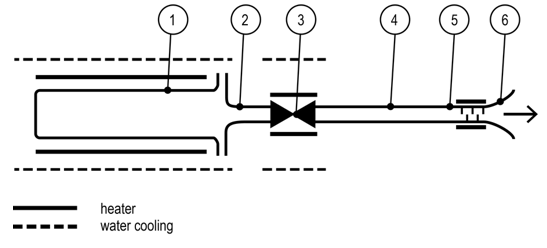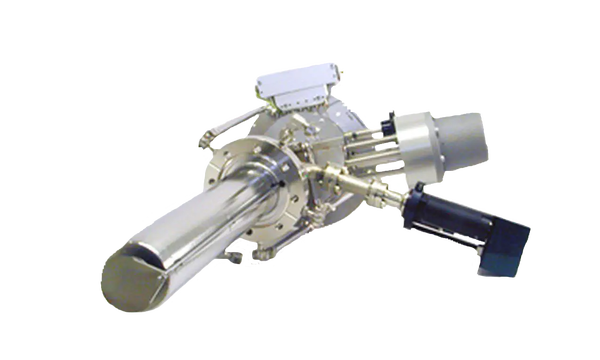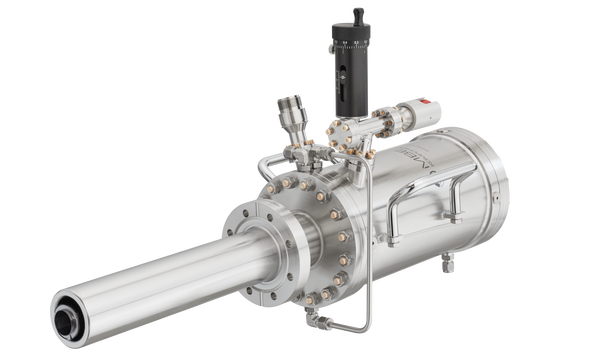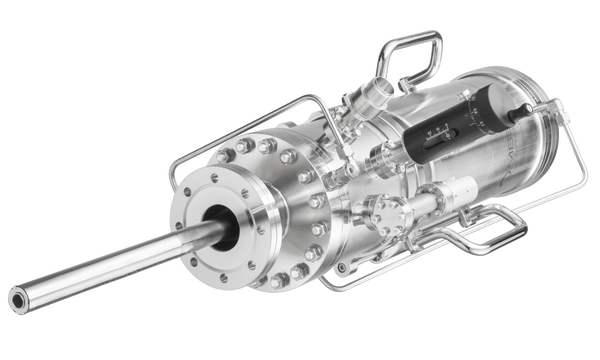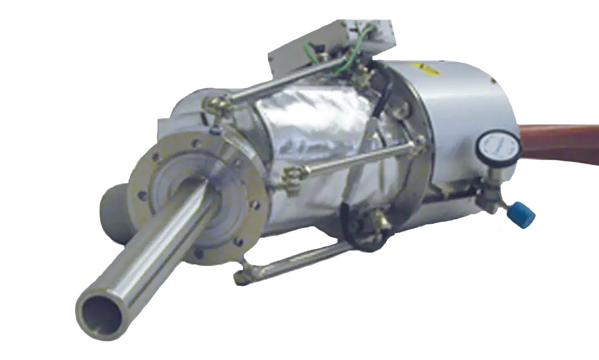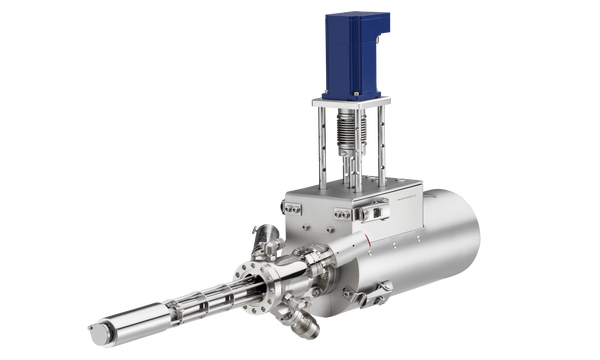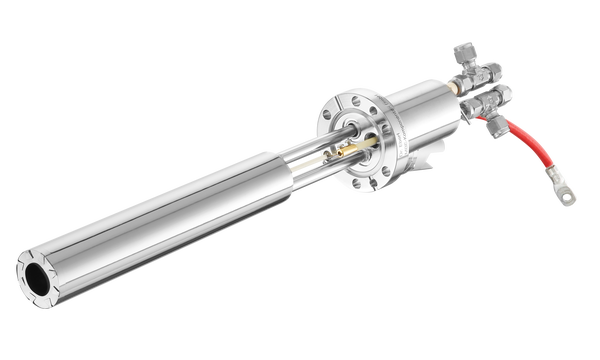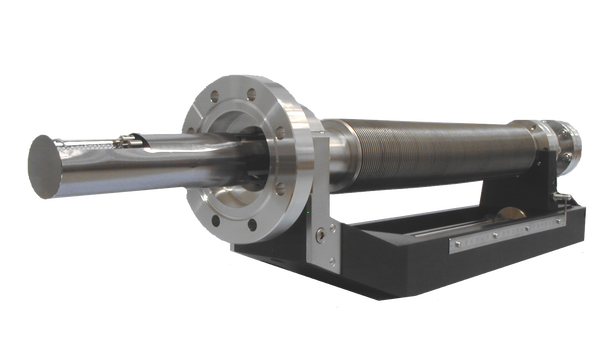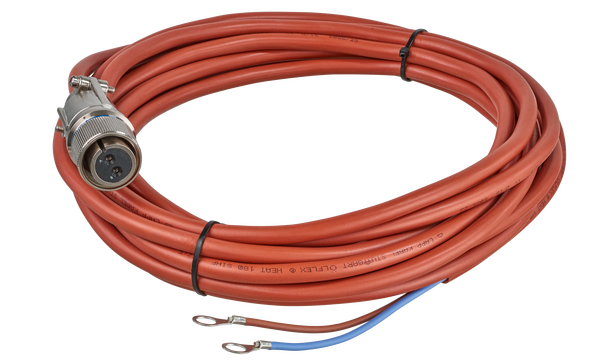- Evaporation and cracking of Sb, Te, Mg, and other corrosive materials
- Large crucible capacity of 420 cm³
- All PBN construction of valve and cracker stage
- Fast, stable and reproducible flux control
- Easy installation and refilling procedure
- Injector length and mounting flange adjustable to fit most MBE systems Datasheet
Introduction
The Valved Corrosive Material Cracker Source VCCS is designed for
controlled injection of radicals of antimony, tellurium, magnesium or
other corrosive materials in standard MBE applications. Parts directly
exposed to the evaporant like crucible, valve mechanism, injector tube
and cracker are solely made from PBN to minimize corrosion of the
cell.
A mixture of larger molecules of, for example, Sb n is produced by sublimation of the evaporant within the reservoir. The resulting beam flux is controlled by an all PBN mechanical valve unit and finally the gaseous molecules are dissociated within the thermal cracker stage to form a molecular beam containing a large ammount of e.g. Sb 2 species.
The source consists of the 420 cm³ reservoir, built into a water-cooled vacuum enclosure that also houses the valve unit, and the injector tube with a thermal cracker unit on top.
Operation of the mechanical valve unit shows fast, stable and reproducible flux control. Together with our valve controller MVCU an easy handling and integration into your MBE system is provided.
Three independent heater circuits allow precise and flexible adjustment of the temperatures in each part of the cell in order to provide sufficient material vapor, avoid condensation within the valve or injector tube and ensure maximum cracking efficiency, each according to the requirements of the particular evaporant. A schematic illustration of the sequence of the different heater stages is shown in the figure on the right.
The special design enables easy and safe refilling of the crucible from the backside of the cell without the need of removing the complete cell from the system.
Application
The main purpose of the VCCS in MBE applications is enhanced flux control and cracking of materials whose vapor is highly corrosive to metallic surfaces. The VCCS was originally designed as a source for an antimony radical (Sb 2 ) molecular beam as group V material in standard III-V MBE. It uses the well-established concept of sublimation of elemental Sb n followed by a step of thermal dissociation in a cracker stage to produce a Sb 2 molecular beam. The VCCS all PBN construction of the inner parts, in particular the valve mechanism, in combination with the flexibility provided by three independent heater circuits allows applying this concept to other materials like Te, Mg or Se.
The valve mechanism and hence the beam flux can be regulated either manually or remotely by a servo motor drive (MVCU) with a 0-10 V analogue input signal.
A large crucible capacity of 420 cm³, fast and precise flux control and easy handling for maintenance and crucible refill make the VCCS an ideal source for smaller production MBE systems as well as for higher throughput research MBE systems.
References
Several publications based on samples grown with VCCS sources are listed in section References / List of Publications .
| Filament type | 3 separate heater-circuits (cell / valve / cracker) |
| Thermocouple | 3 W5%Re/W26%Re (type C) thermocouples (cell / valve / cracker) |
| Operating temperature (for Sb-sublimation) | cell crucible: 550-650°C; valve: 600-700°C; cracker: 650-1200°C |
| Outgassing temperature | cell crucible: 800°C; valve: 900°C; cracker: 1300°C |
| Bakeout temperature | 250°C |
| Cooling | integrated water cooling shrouds |
| Crucibles | 420 cm³ |
| Flux control | integrated all PBN valve mechanism / cell temperature |
| Valve control | stepper motor drive with control unit MVCU |
Dimensions
Specific data
For general information on CF mounting flanges see Flange and Gasketdimensions .
| Product | CF flange | Nominal capacity | UHV dimensions*** [mm] | max. electrical [W]/[A] | Power supply product code | |
|---|---|---|---|---|---|---|
| [cm3 ] | [mm] / [mm] | [W] / [A] | Product code | |||
| VCCS | 100* - | 420**- | LxxxD38 | cell : 315 / 9 valve : 400 / 8 cracker : 455 / 13 | cell : PS
60-12.5-C valve : PS 60-12.5-C cracker : PS 40-19-C |
* other mounting flange diameters feasible in combination with VADP adapter flanges (on request) ** other capacities on request *** specify UHV length L with order
Product code: e.g. VCCS 100-420-L305D38 is a valved corrosive material cracker source on DN100 CF flange with 420cm³ crucible and UHV-length 305mm.


